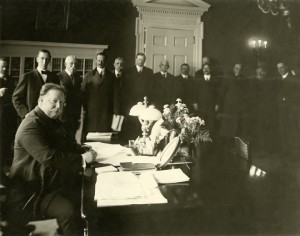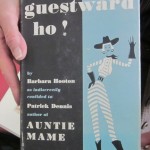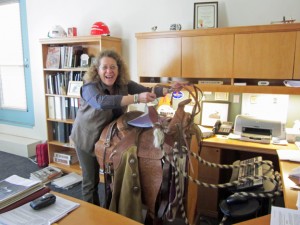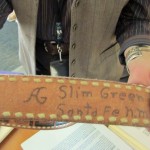 Noel Pugach, a professor emeritus of history at the University of New Mexico, delivered this week’s Centennial Brainpower & Brownbags Lecture in which he explored the story of the man who managed to give New Mexico what it had sought for more than 60 years: statehood. But beyond making New Mexico (and Arizona) a state, President William Howard Taft left a legacy that can best be represented by a shrug of the shoulders.
Noel Pugach, a professor emeritus of history at the University of New Mexico, delivered this week’s Centennial Brainpower & Brownbags Lecture in which he explored the story of the man who managed to give New Mexico what it had sought for more than 60 years: statehood. But beyond making New Mexico (and Arizona) a state, President William Howard Taft left a legacy that can best be represented by a shrug of the shoulders.
“Taft had a distinguished career before and after his presidency, yet most historians rate him as an average president–even mediocre,” Pugach said.
(That’s Taft at left, joined by dignitaries as he signs New Mexico into statehood in Washington, D.C., on Jan. 6, 1912. Photo by Harris and Ewing. Palace of the Governors Photo Archives 89760.)
Theodore Roosevelt preceded Taft and helped him win election in 1908; Woodrow Wilson succeeded him four years later. “He was unfortunately sandwiched between two dynamic men who left their marks on history,” Pugach said. “That’s hard to beat, and here you come in the middle. Taft suffers by comparison.”
He also suffers by having been a poor administrator, owning a political tin ear and displaying a knack for choosing the conservative sides of issues in a country that was then moving left. Not to mention that he ate compulsively to cope with whatever inner demons drove him, ending up at something like 340 pounds while in the White House where, yes, he got stuck in a bath tub. More than once. Laugh if you must, but do take a moment to consider what mental and physical agony he must have suffered. (That said, he was an avid golfer and a darned good dancer.)
 When Taft took office, some conservative Republicans remained stuck on the idea that a New Mexico-Arizona combo state was the only way to go, despite Teddy’s best efforts to dampen their zeal. Taft did some of his own cajoling and negotiating to quell that plan, then had to engage in some last-minute horse-trading that weakened his ideas for regulating the railways in return for granting New Mexico statehood.
When Taft took office, some conservative Republicans remained stuck on the idea that a New Mexico-Arizona combo state was the only way to go, despite Teddy’s best efforts to dampen their zeal. Taft did some of his own cajoling and negotiating to quell that plan, then had to engage in some last-minute horse-trading that weakened his ideas for regulating the railways in return for granting New Mexico statehood.
(At left: Noel Pugach with History Museum Director Frances Levine.)
The Cincinnati native had graduated from Yale where he not only scored good grades but had enough social acumen to win an invitation into the secret Skull & Bones Society. He earned a law degree and embarked on a political career of appointed positions–an important distinction, Pugach said, given Taft’s later inability to succeed at the mano a mano of electoral politics. After he served admirably as chief civil administrator in the Philippines, Roosevelt made him his Secretary of War (despite a lack of military experience) and, though he dreamed of being a Supreme Court justice, Teddy and Taft’s wife, Helen, pressured him to run for the presidency against Democrat William Jennings Bryan. He won handily and eventually amassed a record as a better trust-buster than Roosevelt (though Teddy would get the glory).
He didn’t like Washington and spent so much time traveling that he got a reputation of being out of touch.
“He was a lousy politician,” Pugach said. “He had terrible political instincts. He spoke too candidly. He was inept at horse trading. The press called him `The Blunderer.'”
On the upside: “He was a man who was very bright. He had good intentions. He cared for his country. But by and large, he was unsuccessful in his presidency. This is the man who finally brought us statehood.”
By 1912, when Republicans nominated Taft for a second term, Roosevelt had lost so much faith in him that he formed the “Bull Moose” Progressive Party, thereby splitting the GOP vote and handing victory to Wilson. Taft went happily back to Yale, where he served as a law professor until President Harding gave him his dream job, Chief Justice of the United States.
Of his performance in that job, Pugach said, Taft’s record was … “average.”



